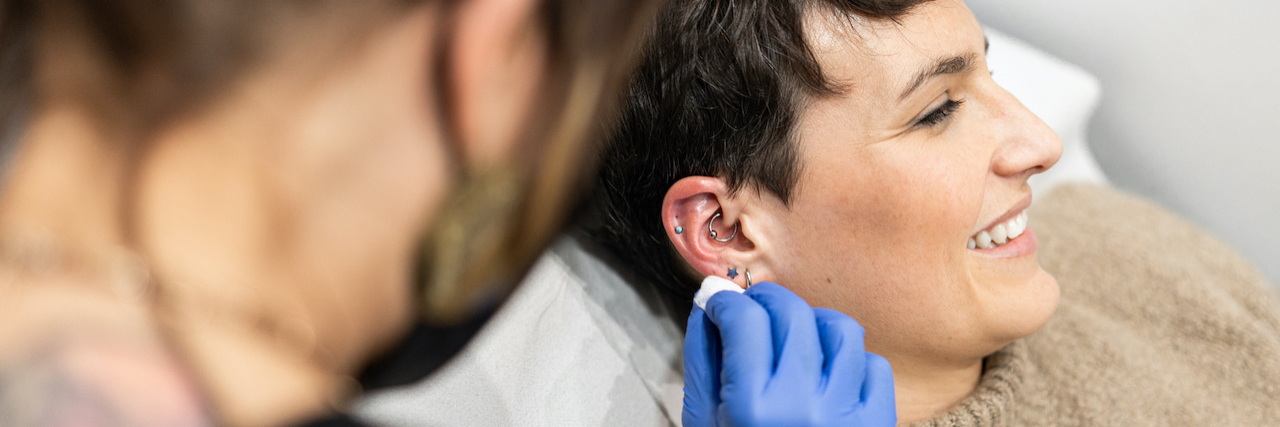Not every migraine treatment works for everyone due to the individualized nature of the disorder. So, it is natural to seek out potential relief in various forms. Daith piercing is a trend that has entered the mainstream with claims of migraine treatment capabilities. But does this fashionable statement hold any weight under the heavy scrutiny of science?
What Is a Daith Piercing?
Daith piercing is an ear piercing that passes through the ear’s innermost cartilage fold, the crus of the helix. While the daith piercing procedure is relatively straightforward, involving a piercing needle and an earring, the process should be performed by a professional to mitigate risks of infection and improper placement.
Daith Piercing: Fashion Statement or Migraine Treatment?
Originally a fashion statement, daith piercing has transcended cultural trends to become associated with health benefits, particularly for those living with migraine.
Migraine Relief Claims and Anecdotal Evidence
The journey of daith entering into the migraine conversation is powered by anecdotal evidence. Several people have reported reductions in migraine frequency and intensity following the procedure, leading to a surge in popularity. However, the plural of anecdote is not data, and these personal stories, while valid experiences, do not equate to scientific research.
Investigating the Evidence
When it comes to evidence-based medicine, the standards are high. Treatments must be backed by rigorous scientific research, ideally through randomized controlled trials that can conclusively demonstrate efficacy. Unfortunately, for daith piercing research, the body of evidence is thin. No substantial studies have verified daith piercing as an effective migraine treatment, leaving it in the realm of speculation rather than substantiated fact.
The Risk of Relying on Unsubstantiated Claims
Opting for a daith piercing in the hope of migraine relief is a decision that carries risk, primarily if it leads you away from proven, evidence-based migraine treatments. It’s crucial to apply scientific scrutiny to such claims and consult with health care professionals before exploring such avenues.
The Verdict on Daith Piercing for Migraine
While daith piercing may be a stylish and culturally significant form of self-expression, its purported benefits for migraine treatment remain unproven. Until we have solid research supporting the use of daith piercing for migraine, it’s wise to approach this option cautiously and prioritize medical advice grounded in scientific evidence.
Understanding Migraine and Verified Treatments
Migraine attacks are far more than just headaches. Migraine is a multifaceted disorder characterized by symptoms such as severe head pain, sensitivity to light and sound, and nausea. Treatment is often multifaceted, combining acute and preventive medications with lifestyle modifications to reduce trigger exposure and improve overall well-being.
How Migraine Works
The underlying mechanisms of migraine involve intricate neurological and vascular changes. It’s thought that migraine is due to a combination of biopsychosocial factors, leading to alterations in brain chemicals and pathways that affect blood flow and pain sensation. This complex interplay results in the all-too-familiar throbbing pain and associated symptoms.
Evidenced-Based Migraine Treatments
Evidence-based migraine treatments have been rigorously tested and validated through scientific research. Medications such as triptans, which target serotonin receptors, and CGRP inhibitors, designed to block the calcitonin gene-related peptide that plays a significant role in migraine attacks, are at the forefront of pharmaceutical approaches. Meanwhile, non-pharmacological strategies like cognitive-behavioral therapy aim to help individuals change the thoughts and behaviors that can exacerbate migraine pain.
Risks of Misinformation and Unproven Treatments
The allure of unproven treatments presents significant risks. Daith piercing, for instance, carries potential complications such as infection and allergic reactions, not to mention the less tangible danger of veering away from professional medical guidance. When unverified treatments are chosen over established ones, the result can be more frequent or severe migraine episodes, potentially leading to chronic migraine and a reduction in life quality.
Identifying and Avoiding Health Misinformation
To avoid the pitfalls of health misinformation, it’s imperative to assess the credibility of sources critically, seek out the scientific consensus, and maintain an ongoing dialogue with health care providers. This approach is vital when considering alternative treatments for migraine. While some may offer relief, it is worthwhile to ensure they have been subjected to scientific scrutiny.
Alternative Therapies With Scientific Backing
Alternative treatments may offer relief for those living with migraine, with some level of scientific support validating their efficacy.
Acupressure, an alternative therapy rooted in traditional Chinese medicine, stands out as a non-invasive option for those managing migraine. Research indicates that acupressure may help reduce the frequency and severity of migraine episodes. By applying pressure to specific points on the body, this technique helps release muscle tension and improve circulation, which can alleviate pain and induce relaxation.
While not a substitute for medical treatment, acupressure offers a complementary approach that can be integrated into a comprehensive migraine management plan, always with the advice and oversight of a health care professional.
Biofeedback and Migraine Management
Biofeedback is an example of an alternative therapy with a solid research foundation. It teaches individuals to control certain physiological processes that can contribute to migraine, such as muscle tension and heart rate, potentially reducing the frequency and severity of migraine episodes.
Supplements and Nutraceuticals for Migraine
Supplements and nutraceuticals also play a role in migraine management for some individuals. Magnesium, for example, has been linked to migraine prevention in some studies, and riboflavin (vitamin B2) has shown potential benefits. However, these should only be taken with medical oversight, as they can interact with other medications and have side effects.
As you navigate migraine management, prioritize evidence-based practices and consult your health care provider when considering any new treatment.
Getty image by Alavin photo

